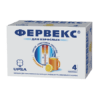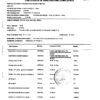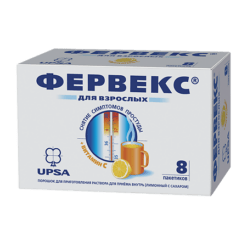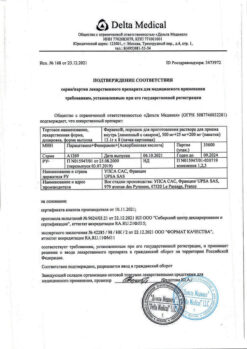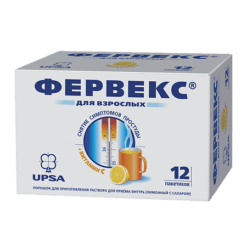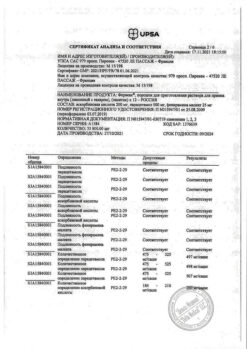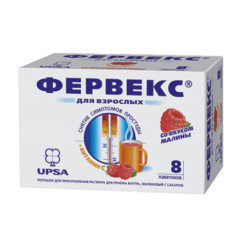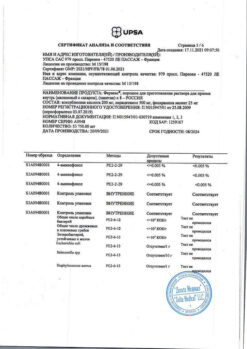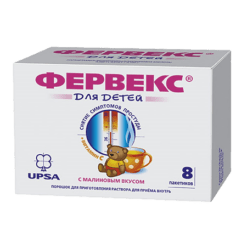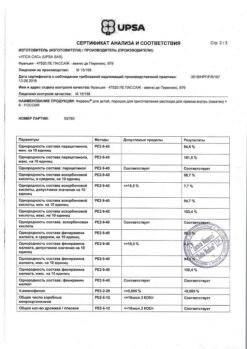No products in the cart.
Vervex, 4 pcs.
€5.99 €5.24
Out of stock
(E-mail when Stock is available)
Description
Fervex® is a combined preparation that contains paracetamol, pheniramine and ascorbic acid. Paracetamol is a non-narcotic analgesic, blocks cyclooxygenase, mainly in the central nervous system, affecting the centers of pain and thermoregulation; it has analgesic and antipyretic effects.
Pheniramine is a blocker of H1-histamine receptors, it reduces rhinorrhea and lacrimation, eliminates spastic phenomena, edema and hyperemia of the nasal cavity mucosa, nasopharynx and sinus cavities. Ascorbic acid is involved in the regulation of redox processes, carbohydrate metabolism, blood coagulation, tissue regeneration, the synthesis of steroid hormones, reduces vascular permeability, reduces the need for vitamins B1, B2, A, E, folic acid, pantothenic acid. Improves tolerance of paracetamol and prolongs its action (associated with prolongation of the T1/2.
Pharmacokinetics
Paracetamol:
After oral administration is quickly absorbed from the gastrointestinal tract. Maximum plasma concentrations of the drug are reached 10-60 minutes after ingestion. It is rapidly distributed throughout the body tissues and penetrates through the blood-brain barrier. Binding to plasma proteins is insignificant and has no therapeutic value, but increases with increasing dose.
Metabolism occurs in the liver, 80% of the taken dose reacts with glucuronic acid and sulfates to form inactive metabolites; 17% undergoes hydroxylation to form 8 active metabolites, which conjugate with glutathione to form inactive metabolites. One of the hydroxylated intermediate metabolic products exhibits hepatotoxic effects.
This metabolite is neutralized by conjugation with glutathione, but it can cumulate and in case of paracetamol overdose (150 mg paracetamol/kg or 10 g oral paracetamol) cause hepatocyte necrosis. It is excreted by the kidneys as metabolites, mainly as conjugates. Less than 5% of the administered dose is excreted unchanged. The elimination half-life is 1 to 3 hours.
Pheniramine:
It is well absorbed in the digestive tract. The elimination half-life from blood plasma is one to one and a half hours. It is eliminated from the body mainly through the kidneys.
Ascorbic acid:
Well absorbed in the digestive tract. Time of maximum therapeutic concentration (TCmax) after oral administration – 4 hours. It is metabolized mainly in the liver. It is excreted by the kidneys, through the intestine, with sweat, unchanged and as metabolites.
Indications
Indications
Active ingredient
Active ingredient
Composition
Composition
How to take, the dosage
How to take, the dosage
Interaction
Interaction
Ethanol increases the sedative effect of antihistamines (pheniramine), therefore its intake during treatment with the drug Feverex® should be avoided. In addition, ethanol in concomitant use with pheniramine promotes acute pancreatitis,
Pheniramine in the preparation Fervex ® enhances the sedative effects: morphine derivatives, barbiturates, benzodiazepine and other tranquilizers, neuroleptics (meprobamate, phenothiazine derivatives), antidepressants (amitriptyline, mirtazapine, mianserine), antihypertensive drugs of central action, sedatives belonging to H1-blockers, and baclofen, which not only increase sedation, but also increase the risk of side effects of the drug (urinary retention, dry mouth, constipation).
The possibility of increased central atropine-like effects when used in combination with other agents with anticholinergic properties (other antihistamines, antidepressants of the imipramine group, phenothiazine-type neuroleptics, m-choline blocking antiparkinsonics, atropine-like antispasmodics, disopyramide) should be considered.
When using the drug together with inducers of microsomal oxidation: barbiturates, tricyclic antidepressants, anticonvulsants (phenytoin), flumecinol, phenylbutazone, rifampicin and ethanol, the risk of hepatotoxic effects increases significantly (due to the included paracetamol).
Glucocorticosteroids when used concomitantly increase the risk of glaucoma. Concomitant use with salicylates increases the risk of nephrotoxic effects. Concomitant use with levomycetin (chloramphenicol) increases the toxicity of the latter.
Paracetamol contained in the drug increases the effect of indirect anticoagulants and reduces the effectiveness of uricosuric drugs.
Ascorbic acid increases the blood concentration of benzylpenicillin and tetracyclines; at a dose of 1 g / day increases the bioavailability of ethinylestradiol (including those included in oral contraceptives). Improves intestinal absorption of iron preparations (converts trivalent iron to divalent iron); may increase iron excretion in concomitant use with deferoxamine. Reduces the effectiveness of heparin and indirect anticoagulants. Concomitant use with acetylsalicylic acid (ASA) increases urinary excretion of ascorbic acid and decreases excretion of ASA. Asc reduces the absorption of ascorbic acid by about 30%. Increases the risk of crystalluria during treatment with salicylates and short-acting sulfonamides, slows renal excretion of acids, increases excretion of alkaline drugs (including alkaloids), reduces the blood concentration of oral contraceptives. Increases total clearance of ethanol, which in turn reduces the concentration of ascorbic acid in the body. Quinoline drugs, calcium chloride, salicylates, glucocorticosteroids deplete ascorbic acid during long-term use. When concomitant use ascorbic acid reduces chronotropic effect of isoprenaline. With long-term use or use in high doses may interfere with the interaction of disulfiram and ethanol. In high doses increases excretion of mexiletine by the kidneys. Barbiturates and primidone increase urinary excretion of ascorbic acid. Reduces the therapeutic effect of neuroleptics – phenothiazine derivatives, tubal reabsorption of amphetamine and tricyclic antidepressants.
Special Instructions
Special Instructions
Contraindications
Contraindications
Side effects
Side effects
The drug is well tolerated in the recommended doses. The following side effects have been reported with the use of the drug (frequency is not determined):
Blood and lymphatic system disorders: anemia, leukopenia, agranulocytosis, thrombocytopenia;
Immune system disorders: Allergic reactions (erythema, skin rash, itching, Quincke’s edema, anaphylactic shock);
Nervous system disorders: drowsiness, confusion, hallucinations, impaired concentration (more common in older patients), agitation, nervousness, insomnia, coordination dysfunction, tremor;
Visual disorders: Accommodation impairment;
Heart disorders: palpitations;
Vascular disorders: orthostatic hypotension, dizziness; Gastrointestinal disorders: Dry mouth, nausea, vomiting, abdominal pain, constipation;
Renal and urinary tract disorders: urinary disorders.
In case of adverse reactions, stop taking the drug and see your doctor.
Overdose
Overdose
Pregnancy use
Pregnancy use
An adequate and well-controlled study of Fervex® in pregnant women has not been conducted, therefore it is not recommended to use the drug in this group of patients.
It is unknown whether the active ingredients of the drug penetrate into breast milk. The drug should not be used during lactation.
Similarities
Similarities
Additional information
| Shelf life | 3 years. |
|---|---|
| Conditions of storage | Store at 15 to 25 oC. |
| Manufacturer | UTSA SAS, France |
| Medication form | Powder for preparation of solution for oral administration |
| Brand | UTSA SAS |
Other forms…
Related products
Buy Vervex, 4 pcs. with delivery to USA, UK, Europe and over 120 other countries.





